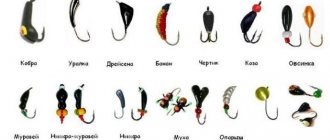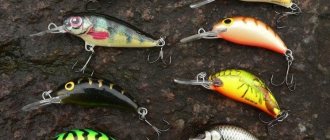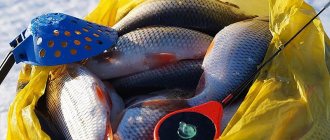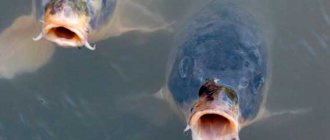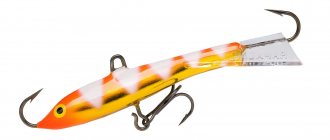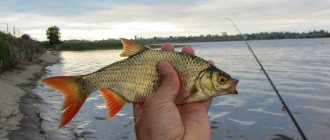Roach is a small silvery fish of the carp family, distributed throughout almost the entire territory of Russia; There are hardly any bodies of water where it does not live.
The roach settles in ponds, rivers and lakes, choosing shaded places near the roots of trees, under sunken snags, and among aquatic vegetation. Prefers quiet, sun-warmed shallow water, avoids strong fast currents, swampy and silt-covered places. The turbidity raised by the spring flood forces the roach to retreat into oxbow lakes and bays; it does not like dirty water.
Jigs for roach
Jigs can be made from:
- lead;
- tungsten;
- tin;
- various alloys.
Lures vary in weight and are divided into four groups:
- Super heavy - usually made of a metal alloy that is heavier than lead and tin.
It includes tungsten alloy, but jigs from it began to be made not so long ago. It's all about difficult processing - the metal doesn't solder well. The hook to the weight has to be placed in a specially sawn groove, then it is filled with solder. This mount is not reliable, and the holes for the line have sharp edges, so it can quickly fray. However, all these flaws fade away in the light of the advantages of using a heavy-weight jig - the greatest weight with a small size. The bait always reaches the desired depth with great speed; There are about 20 colors available, ranging from 0.3 g to 0.8 g. This one is selected for larger individuals. Important: you can avoid breaking the line if you make the hole a little larger and pass the casing from a thin wire through it. Cut it so that it covers the sharp edges and pass the fishing line through. In any case, bandage it more often so as not to regret losing it. - Heavy - often consist of lead or together with cupronickel, copper, silver.
The advantages of the jig are that it is suitable for fishing at great depths; the current almost does not carry it away. Know: if you are going to fish on a frosty and windy day, this bait is better suited. In such conditions, the hole quickly becomes covered with ice, and the forests freeze over. Then it is very difficult to lower it into the desired area, especially at a fast pace if a school of fish has approached. - Medium - often made from tin and its alloys.
They are easy to manufacture; many fishermen solder them at home. They are the most popular among winter fishing enthusiasts. Tip: Tin is quite easy to solder, so if you want to prevent the line from quickly fraying, simply make the edges of the hole oval using a soldering iron. - Lightweight – designed for shallow depths.
Different materials are used in production - thin plates of brass, silver, cupronickel. Only add enough solder to seal the hook and not add weight to the bait. Remember: in the production of jigs of this group, epoxy resin, plastic, and elastic nylon can also be used. The bait works like a miniature gliding spoon, often painted with additional dyes to attract fish.
Mormyshki differ:
- Fishing experience shows that in any weather and depth, dark-colored baits work well, but on rainy days and at depth, light-colored baits become more effective
Method of fastening and number of hooks . Hooks can be attached from one to four. It is believed that a good result will be achieved by using soldered single and double hooks. A triple combination can create symmetry, then the blende will move only vertically. But you can use a trick - attach the tee to the ring, then its additional movements in the reservoir will attract prey. The hook has its own requirements - its tip must be perfectly sharp, and the solder must be reliable. Otherwise, production collapses are possible.
- Size:
- small – 0.5 cm
- medium – 0.9 cm
- large – over 0.9 cm.
All jigs are divided into:
- for summer;
- for winter.
Summer lures are usually larger because they are designed for fishing in open water where strong winds and waves are possible. After spawning, the roach looks for places rich in food - these can be dense thickets of water lilies, where dragonfly larvae, amphipods, and small worms live.
Small roach are found here in abundance. Catching one with a jig is a pleasure: you just have to constantly let it sink to the bottom. Larger individuals gather in flocks in the space between the dips; they prefer ruts and dumps; you will have to look for it deeply. You can hunt both from the shore and from a boat.
Important: a summer jig helps to successfully fish pools adjacent to shallow water, with a silt-rocky or clay bottom. The bait will be indispensable in reed and sedge thickets.
Remember : for a reservoir with a depth of up to 4 m and the absence of a strong current, a jig weighing 0.5 g is suitable. For greater depths with a powerful current, it is better to take an elongated bait weighing up to 1 g.
Information: for small jigs, hooks with a long shank are suitable - No. 10-15, for large jigs - No. 6-8. Fishing experience shows that in any weather and depth, dark-colored lures work well, but on rainy days and at depth, light-colored lures become more effective. It has been noticed that as the water temperature decreases, roach bites on jigs of golden and reddish shades.
Still, jigs are most often used in winter fishing - by 90%. Finding a good place for biting is not difficult, since usually the catchable places remain in one place from year to year. Mid-January is good for fishing on a calm day during snowfall.
Advice: it is better to choose a shallow area near the shore or one where small rivers flow. The roach bite noticeably improves in cloudy weather, but with a stable air temperature. You can fish on the last ice, while the fish begins to move to the mouths, and then to the upper reaches of the rivers.
For winter fishing, it is better to choose baits of black or dirty green colors; lead, brass and gray copper baits are also suitable. The size and weight of the bait is selected based on the depth of the reservoir. The deeper the fishing spot, the heavier the jig should be, but at the same time as small as possible. Experts recommend using tungsten blende; they sink to the bottom better than lead ones.
Important: roaches may be frightened by bright sunlight, so on such a day it is better to sprinkle the hole with snow.
According to the method of fishing, jigs are also divided into 2 groups:
- Without a nozzle (“reelless”) - mainly used in winter fishing. The name itself speaks about the essence of the bait - fishing with bare hooks. Sometimes inedible objects are put on the hook: beads, rings, pieces of cambric, etc. The purpose of such decoys is to play the role of underwater living creatures that the roach hunts. The most successful baits in this group are considered to be: “Devil” - can have different shapes: drops, ovals, cylinders, balls. Has three soldered hooks. For better bite, experts additionally equip the hook with multi-colored beads, which are secured with pieces of cambric. In a reservoir, the “Devil” takes a vertical position and moves up and down.
- “Uralka” – equipped with a single hook. A bead is attached to it, which can be of a variety of colors. The shape is slightly elongated and curved; in water, in addition to vertical movements, it can also make horizontal ones.
- “Goat” - outwardly resembles “Uralka”, however, it has two hooks in its arsenal, they evoke thoughts of goat horns. The weight of the bait ranges from 0.3–0.8 g. The outer part is dark in color, and brass or copper foil is often soldered to the inner part. This combination contributes to the shimmering effect in the water.
- “Nymph” – created for the most accurate imitation of an insect. It is based on a simple trompe l'oeil, which is equipped with the addition of threads, feathers, pieces of fur, antennae and insect limbs. “Ant” is a super popular decoy among fishermen. It resembles the body of an ant with a clearly defined head and body, and the hook is complemented by brightly colored cambrics. Sometimes the hook is equipped with a bead with a large hole so that it moves freely, imitating an insect egg.
- “Guns” (“Ball”) – come in two types: with through holes or loops. They are made primarily from lead or tungsten. The “pellet” is painted black and can be coated with brightly colored varnish and a light-accumulating composition. Remember : if you fish at depth with current, take tungsten. And with a nozzle-free technique, lead will be more effective. Pay attention to the size of the bait - most reservoirs and fishing conditions are suitable for jigs with a diameter of 2.5–3 mm. If you plan to fish at a depth of more than 5 m, you need to select a larger pellet.
Features of catching roach in winter with a jig
Catching roach in winter is an opportunity to settle in places where you can’t get close in summer.
On the first ice, fish should be fished at depths of up to three meters. She tries to stay in the remaining vegetation. Roach also moves around the water area, but has its own favorite places. These are tributaries flowing into the lake. Fish is searched for by the number of holes.
When entering the ice, the angler drills a hole and begins to fish. It takes about ten minutes to find out if there are fish here. If a school is discovered and there are bites, then you also need to find out where the concentration of fish is greatest. A larger number of holes are drilled and the most catchy one is selected.
You need to behave a little differently in small bodies of water, usually overgrown with reeds. By its appearance you can determine the depth, because the reed grows no more than one and a half to two meters. It would be good to drill a hole in the reeds themselves.
The color of the jig can make a difference and should be changed. On the first ice, after this individual you need to take a “Uralka”, “ant”, “nymph”. It is better to choose dark colors. Ideally, you need to have several wormless jigs and jigs for attaching bloodworms.
In the wilderness, this species practically does not feed and reacts poorly to various baits. At this time, anglers use feeding and the smallest jigs.
Fishing tactics
In December, individuals are caught at depths. The ice is already completely covering the lakes and the fish are moving to deep places where there is food. Roach especially likes to be at changes in depth, in holes, near cliffs. Throughout the month, it shows high activity, but like all fish, it does not tolerate weather changes well. At high pressure and unstable temperature, a good bite is impossible. As soon as all this stabilizes, the fish feed again.
To improve the bite, some fishermen decorate the tackle with various beads, cambrics, and chains. Roach is very inquisitive; by combining the colors of different devices, you can significantly increase interest in the bait. Individuals prefer bright colors.
The most common tactics for catching this species are as follows. Having discovered the area where the fish should be, several holes are made. Then these holes are constantly and daily fed and sometimes the catch is decent. But gradually the fish begins to be capricious and cautious. The fishermen go to another place.
Fishing technique
When fishing for roach in winter, the techniques differ from those in summer. An experienced angler is a master of the game with artificial bait. After all, the play of the tackle depends on its shape, flow, and elasticity of the nod. The work is done with a relaxed hand, the movements themselves are done only with the hand.
Some techniques for winter roach fishing:
- the tackle is thrown to the bottom, trying to hit it or raise mud;
This can attract fish, then slowly vibrating with a nod, they lift it up 30-40 cm. Now they quickly lower it back to the bottom, the length of the pauses between these cycles is 3-4 seconds;
- slowly lowering the hook to the bottom, stretch it from side to side by 2-3 cm, then begin to lift it, stopping for 2-3 seconds;
If the water is clear, then bending over the hole, you can see the hook and the movements assigned to it. Hooking is done only with a fishing rod; fishing is done by hand. Having made the hook, the fishing line is picked up with the left hand, the fishing rod is placed on the ice, and fishing begins.
Everything is simpler here than in summer. Fish do not have such activity and strength. Slowly, fingering the fishing line with your hands, the prey is brought to the hole. Now the main thing is not to give any slack in the line. Otherwise there may be a fish escape.
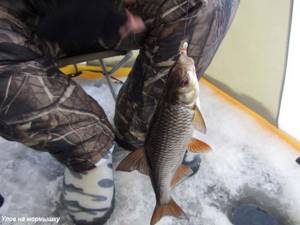
If the catch is large and cannot go into the hole, then it is reddened. This is a very important moment. Radiation must be done in the area of the front fins quickly and decisively.
Like any fishing, winter fishing begins with the search for prey. If in half an hour the nod has not wavered, then you need to change the place. And in order to know where to go, you need to study the habits of fish in winter.
Attaching the jig
On any fishing trip, troubles can occur in the form of a line break and loss of bait. Therefore, it is extremely necessary not only to take care of the reliable fastening of the jig in advance, but also to learn how to tie knots. The key role is played by the fishing line, namely its diameter. Experienced fishermen say that the weaker the bite, the thinner the line should be.
The ideal solution would be a diameter of 0.08–0.09 mm, but it will require some skill. With such a fishing line, it is forbidden to carry out sharp hooks, and when fishing for a large specimen, you should not force events. The fishing line must be new and elastic; using old ones is unacceptable.
Based on the method of attaching the bait, they can be divided into groups:
- With a loop – jigs such as “Devil” and “Goat” are securely attached to a synthetic fishing line with a Canadian figure eight.
- Through ones - with holes inside, require more skill. You should pass a fishing line through the hole in the snag and tie a simple knot. A loop appears at the shank of the hook. The remaining end is wrapped around the hook and loop several times. The line is pulled tightly into a knot. You can do it differently: the line is passed through the hole several times and wrapped around the hook several times.
- Tungsten - should be placed in a separate group, since due to the hardness of the material they often fray the fishing line. The knots are attached in such a way as to prevent contact between the line and the tackle.
- Braid - the main line is attached to the one on which the tackle is held. The fishing line for the tackle is braided, very strong. The main line attracts the braided line and it is pulled through the hole in the tackle. The ends of the braided line are wrapped around the hook and a simple knot is tied.
- Cambric - taken instead of braided wire, heated in hot water so that it stretches and can enter the body of the bait.
Tip: if you don’t want the knots to spread out during fishing, try cutting off the excess line at the knot and melting it over a fire. As soon as you finish fishing, tie the jig again. Do not store jigs in boxes with foam rubber; the hooks in it can quickly rust. It is better to use polyurethane foam.
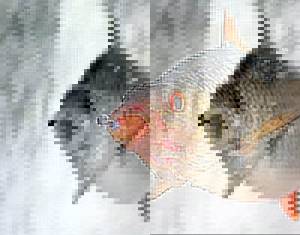
Tricks to use to make a great catch
To significantly improve the result, you should securely attach the antennae to the forend. When there is wiring, they will begin to move. To get such antennae, we take black and red pieces of thread, tie them to the shank of the hook, and then cut off the ends. A jig that is painted with glitter polish (for nails) is especially effective. If you slightly change, say, an ant jig, it will give wonderful results; large roaches will go for it. It's also worth trying to work with others and try them out in practice.
In winter it is always worth experimenting, not only changing the course of the game, but also the bait. It happens that the fish does not want to go for a certain color jig, but then the bite returns again if you use a different jig. There are also some other tricks that help with the bite. For example, take a regular colored marker with you when fishing and use it to change the color of a jig or other part, but do not change the bait itself. Also experiment with beads, this will also give positive results.
In winter, jigs are more practical than, say, a fishing rod. Usually roaches travel in a large school, and therefore fishing is supposed to be active, interesting and bring wonderful catches. You can choose a jig that will attract prey much better. But the main point is that the bait should move naturally, characteristic of living creatures. Such bait will quickly lure prey, and you need to wait for the bite.
Much depends on the skill of the fisherman himself, on his intelligence and attentiveness. In addition to a good jig, also take into account the fact that you need to learn how to play the game correctly. And according to experienced fishermen, they use more than twenty techniques for working with such bait, which means that there is a lot to learn and gain experience. And if you take into account all the recommendations for using jigs for roach in winter, then fishing should be successful with a good catch.
Nozzles for jig fishing and bait
Nozzles for jigs and the role of bait vary somewhat depending on the season:
- Experts recommend using steamed grains of wheat, oats, and rolled oats flavored with hemp or linseed oil for flavor as bait.
In the spring, the best bait will be maggots, dung worms, and bloodworms. The larvae can be planted in clusters; the worms should not have dangling ends. And, of course, the fish will bite well on what the fish are fed with. Know: Although during this period bait is almost useless, since the school moves according to its natural laws, still, as soon as active biting begins, you need to throw new portions of bait into the fishing area so that the timid fish spins in one place. So, you can periodically throw in 10–15 pieces of maggots, a handful of chopped worms or bloodworms mixed with bottom debris. Roaches will not appreciate vegetable bait in the form of pearl barley, dough or wheat in early spring.
- In summer , the roach is picky because it does not need food - the water is full of larvae and plants, and everything goes to it for food. And mostly fish are switching to vegetarianism. Therefore, you can offer algae – filamentous algae – as bait. Tie them with strands and place them on the hook. Experts recommend steamed wheat grain, oats, and rolled oats flavored with hemp or linseed oil for flavor. Attention: it is better to mix the bait on the shore of the pond with water from this reservoir. You can take bran, crushed cake, crackers as a basis, add flavorings and fillers. The filler should be animal components - chopped worms, maggots. For viscosity, clay from the river is mixed, balls are rolled and thrown before fishing. In summer, the fish bite better in the morning.
- In autumn, the fish become especially greedy and rush to eat for the winter. Starting from September, right up to the freeze-up, roach are excellently caught, taking all baits throughout the day, not only in the morning. The colder the water gets, the deeper the fish go. The best bait is mastyrka, maggot, bloodworms, pearl barley. Know: feeding in the fall is a must! The presence of animal components is welcome; in addition to worms and maggots, aquarium food can be used.
- In winter, fishing with a jig is very productive, especially since this tackle is mobile and versatile. A fisherman can drill several holes and move from one to another in search of a successful fishing spot. Of the winter baits, bloodworms are considered the best, followed by maggots and burdock moth larvae. Important: in order to lure a flock of silvers to the hole, you should feed it well. Since this fish looks for food in the water column, and not at the bottom, you need to prepare bait that will dissolve as it falls, creating a cloud of food. The basis of the bait may include semolina and wheat cereals, milk powder, and bran. The main thing is that the components do not stick together and are light. If a flock is found under a hole, you need to start feeding it frequently in small doses.
Fishing in winter begins with the first persistent frosts, when there is ice on the reservoirs. During this period, the flock is actively looking for food and bites on almost everything. And if the weather remains good all winter without changes in atmospheric pressure, you can fish for all three months.
Remember: the most popular “quiet hunt” in winter is fishing with an empty hook—a “reelless” one. However, such fishing is for professional fishermen, since it requires knowledge of the technique of playing with a jig. The roach grabs the bait because its movements remind the fish of its familiar food.
Pellet
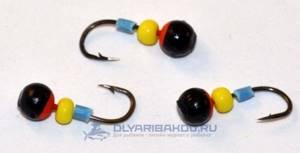
The advantage of shot is that it is available in any fishing store and is very versatile. It can be used throughout the winter season. They catch roaches both with a shot and with bait, and without it. Also in stores there is a large selection of pellets from different materials, different colors, different sizes and weights. The masses of small ball jigs start from 0.1 g.
The best “decorations” for pellet-less pellets are beads or small beads .
They are put on a hook and secured with cambrics. Attention. The pellet is one of those jigs that is often used as a second, additional bait on winter gear.
It is perfect for use in this capacity. In this case, it must be tied on a separate leash, which is located above the main bait. Light pellets weighing from 0.1 g are well suited for just such purposes. A small bait plays more smoothly than the main heavy jig, which often brings excellent catches of roach. In addition, the use of a second jig allows you to fish a larger horizon of the water column. Shot with bait brings good catches throughout the winter season. It is especially relevant in the middle of winter , when the roach is inactive and often refuses to take other baits. On the first and last ice, you can use it in a baited or baitless version, but in the second case, as a rule, other baits – originally designed for reelless fishing – are more catchy.
The best way to animate a pellet is a fast, low-amplitude game, a small shake, or a dribble. When catching roach with this bait, it is worth stopping periodically, this brings a good effect. You can also use smooth animation - calm rises without playing, swaying in the water - but this works worse.
Fishing process
When fishing with a jig, special attention should be paid to the fishing rod and its technical characteristics. They also vary depending on the seasons and year:
- A winter fishing rod should be light and fit well in the palm of your hand, becoming an extension of it, because there is a delicate game of bait ahead. It is better if it is made of foam plastic rather than plastic, so that your hand does not freeze. The fishing rod is equipped with an elastic nod, which is responsible for the sensitivity of the bite. One of the best options for ice fishing is a fishing rod called the “balalaika.” It does not have a long handle; it is replaced by a small reel, by which the fisherman holds the tackle. There are winter fishing rods with a friction clutch, which can prevent the line from breaking while fishing for prey.
- Summer The fishing rod is different from the winter one - it is much longer, since you often have to fish from the shore and the casting distance matters. They are distinguished by the use of lateral nods, which are easier to observe from afar. The larger the rod, the longer the nod should be. The correct nod prevents sharp fluctuations and allows for smooth play with the jig. For summer there are 2 types of fishing rods:
- With blind equipment - take a fishing rod 6–10 m in length. Its size changes thanks to the possibility of extending the telescopic knee. At the top of the rod there is a reel mounted, where there is a supply of fishing line. The fishing line for this gear is chosen to be thin – 0.10–0.15 mm, transparent and durable.
- With running equipment - a rod with guides and a reel containing fishing line. The reel allows you to change the immersion depth of the jig. This gear makes it possible to catch large specimens when using a friction brake.
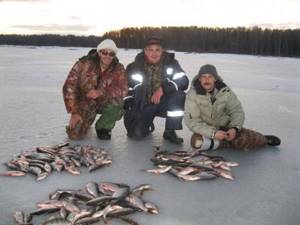
A winter fishing rod should be light and fit well in the palm of your hand, becoming its continuation, because there will be a delicate game of bait
Lure weight
The weight of the bait plays a big role. This directly affects how the game will play out, as well as which nod or line to choose. You need to understand that a light jig, which is tied to a thick fishing line, will take too long to sink. As for a heavy bait, but on a thin fishing line, it is not suitable because the desired game will not work with it, because the fishing line will constantly sag.
It is also worth paying attention to the nods, which are adjusted based on the weight of the jig. By the way, it is for this reason that many fishermen mark their baits and “guards”. The nod also ensures the action of the bait, which is very important when fishing for roach without bait.
Catching roach with a jig in winter will depend on both the depth and the weight of the product.
It is advisable to pay attention to this ratio of mass and depth:
- If the depth is within two meters, then the weight is 0.3-0.5 grams.
- From four to five meters – 1 gram.
- More than 5 meters – 1.2-1.5 grams.
In order to achieve better results, it is advisable to use tungsten jigs at depth, and lead jigs are suitable for shallow water.
As for advice regarding the correct choice of nod, in this case each angler should be guided by his own needs. Even experienced fishermen do not give any recommendations in this regard. It is only necessary to say that the parts are made of lavsan, metal plates, x-ray film, polycarbonate and polyethylene. If you wish, you can make a nod with your own hands, which will perform its task no worse than a purchased one. The main thing is that the appropriate guard is selected for the bait.
How to catch roach
Fishing techniques vary according to fishing conditions - in the current or in still water, and according to seasonality:
- Fishing in still water in summer requires casting the bait as far as possible, and as soon as it reaches the bottom, you should start jerking or dragging along the shore. The game process involves tapping your finger on the fishing rod where the reel is attached to oscillate at a certain frequency. Advice: if the reservoir is heavily covered with vegetation, look for a distant “window” where there is no vegetation, otherwise a snag may occur. Do not stand in one place for a long time; if the bite fails, it is better to move to another area.
- Fishing in the summer on the current involves keeping the lure close to the ground of the reservoir. The technique is as follows: first, cast upstream, and as soon as the bait falls to the bottom, begin a smooth retrieve. The game should be soft and flexible; you shouldn’t raise the jig high, but you shouldn’t lower it either. In this case, the fishing line should always be in a vertical position relative to the surface of the water.
- Fishing in winter on the current - recommended during the thaw. To do this, longitudinal ice holes are made along the flow, 4–5 m long and 0.5 m wide, in areas with a depth of 2–3 m. They fish with a short rod, using beads and cambric instead of bloodworms. Scaffolding is needed thicker than usual - 0.14–0.16 mm. The hook must be swift and instant.
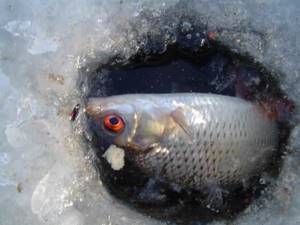
Deep jigs
This version of jigs is used for catching roach, provided that the depth in the area exceeds three meters. The design of the bait is necessarily complemented by a bead of red, black or pearlescent color. A jig can be used for fishing on its own or in addition to bloodworms and maggots, which are placed on a hook behind the head. The use of such jigs significantly reduces the number of idle and empty bites.
Read! Secrets of catching chub in winter with a jig
Ways to play with a jig
Playing with a jig is the whole science of attracting roach. Experts say that there are about 20 techniques for working with it. Summer technology differs from winter technology.
The summer game includes the following techniques:
- after casting, very slowly, without unnecessary swaying, lift the bait from the bottom;
- lower it to the ground again, and then again, without haste, raise it by about 20 cm and stop;
- place the jig on the bottom and stir slightly;
- gently rocking lower the snag, stopping at moments;
- lift by 20 cm and move from one side to the other;
- drag along the bottom with short stretches and long stops.
The winter game is played differently:
- the jig smoothly sinks to the bottom;
- further, a lift up to 3 cm is also gently made;
- lower again for a few seconds;
- This is how a kind of tapping is performed on the ground of the reservoir;
- vertical oscillatory rises in height of 30 cm are made;
- falls again;
- the snag shakes at the very bottom.
Know: beginners can practice at home by filling a bathtub or bucket with water. And when the time comes, the techniques will already be practiced.
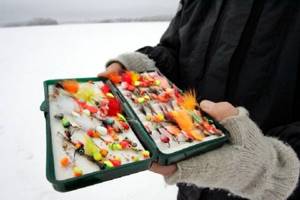
Making a jig with your own hands
The stores have a huge selection of all kinds of baits, however, these are consumables, and some fishermen prefer to make them themselves.
Handymen have learned how to make all kinds of decoys, but we will consider the order of the most popular and simplest: from a hook and a shot:
- take a pellet with a diameter of 4 mm and compress it with pliers to a thickness of 3 mm;
- Without releasing the pellet from the tool, use a file to file a small area for the hook solder site;
- hook No. 1-No. 3.5 and the soldering area are treated with acid and tinned, then the hook is soldered;
- The hook is equipped with a multi-colored cambric of about 2 mm.
This bait is designed for fishing at a depth of 3–3.5 m.
Blitz tips
Finally, a few little tips for successful fishing:
- Please note that a small roach is captivated by active play , while a larger roach is attracted to passive play.
- If, when biting, the nod bends downwards , it means that the silverfish has grabbed the bait and you need to hurry up with the hook.
- When fishing on the shore in the summer, do not forget to remove the reel from the brake if you feel the capture of a large specimen. The line release will increase and fishing will become much easier.
Fishing with a jig can become your most catchy fishing experience only with the correct selection of gear, taking into account the time of year, weather conditions, knowledge of bait techniques and the rules of fish behavior.
What colors are jigs?
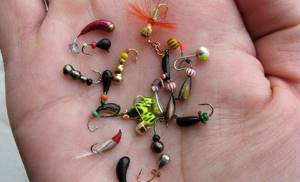
Some fishermen convince beginners that the jig should be selected solely based on its shape. The rest is up to the fisherman: whether he can use it correctly or not. Of course, these are important points, but we should not forget about the color of the products, which also plays an important role in the matter. In addition to the usual metallic shades: gold, reddish, gray or silver, you can find many other beautiful and bright elements on sale.
There are anglers who used green jigs for roach in winter and were very successful.
Although it is best to navigate based on weather conditions. So, at great depths and on a cloudy day, it is advisable to use light-colored products. In clear weather and in shallow water, dark jigs are used.


